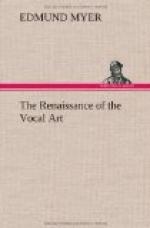Another way to do this, is to start the tone spontaneously by impulse through correct action; in doing so, think and feel as though the tone placed and reflected at the same instant, forward against the roof of the mouth and on the chest,—as though the contact or impingement of the tone were felt at both places simultaneously. Of course the high forward placing in mouth and face is the true placing, and the sensation on the chest is the action or reflection of the true placing. This can be done through flexible vitalized action alone. With a tight throat or local muscular effort it is impossible. This is perfect attack, and in this way all force and push are avoided. In this way freedom and inflation are secured, that condition which unites head and chest resonance.
Think of a rubber pouch filled with air. Imagine you grasp it in the middle with the hand, and close the hand tight. The upper part of this pouch represents the face and high forward placing. That below the hand, or the lower part, the chest resonance. The hand holding the middle of the pouch represents the throat. So long as the hand contracts tightly the middle of the pouch, there is no connection between the air in the upper and lower parts of the pouch. If the desire is to connect these two parts, relax the hand a little, and allow an opening or a free passage between them. In singing, the same relaxation or opening must occur at the throat, if the desire is to connect the ring of high placing with the resonance of the low cavities. If the desire is to reinforce, to build down, the extrinsic muscles of the throat must relax, and the throat must expand.
In thus placing and reinforcing tone, the pupil is guided or assisted not only by the sense of hearing but by the sense of feeling. There will be the sensation of freedom, of ease, of power; a feeling as though the entire body from the head down to the waist were open and filled with tone. Remember, however, this important fact, that it is possible to lift and expand, and even to let go, and yet not to influence the tone. We can act well and yet sing with a common tone. The pupil must think and feel the tone, must think and feel the effect desired. The thought must precede the action.
This point is worthy of all consideration,—right thought or right feeling assists the tone in every way, has, in fact, a wonderful influence in developing right action. The idealized tone brings into action more of the true powers of the singer than it is possible to do in any other way.
[Illustration: SIXTH STUDY. Ya, ah.]
This study lends itself easily and naturally, not only to the development of high placing, but to correct bodily action.




